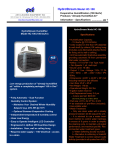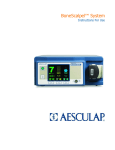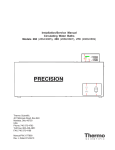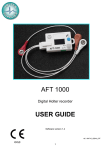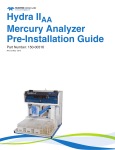Download Integra® Omni-Tract® - Integra LifeSciences
Transcript
Integra® Omni-Tract® Table Mounted Retractor Systems Instrument Cleaning, Sterilization and Care Instructions Instructions for Use/English Indications for Use Integra® Omni-Tract® Table Mounted Retractors are intended to provide stable retraction during invasive surgery to enable temporary retraction and direct visualization of target tissues and organs. Warning DO NOT flash sterilize the Integra Omni-Tract Instruments. The instruments have not been validated for flash sterilization. Discard instrument after suspected Creutzfeldt-Jakob Disease (CJD) exposure. Pre-Use, Handling, and Inspection of Instruments • Read the Instructions for Use and keep them in a safe place. • Use the product only in accordance with its intended use, see Indications. • Use of an instrument for a task other than that for which it is intended could result in a damaged or broken instrument, or one which provides an unsatisfactory performance. • Instruments should be handled and operated by personnel completely familiar with their use, assembly, and disassembly. • Instruments must be rendered safe for handling, inspection, and assembly while wearing appropriate personal protection equipment (PPE) as promulgated by OSHA and AORN. • Inappropriate use of instruments will lead to damage that is usually not repairable. • Instruments must be thoroughly inspected upon receipt and prior to use to assure proper functioning. Failure to make a complete inspection to assure proper operation and function of instrument may result in unsatisfactory performance. • Integra Omni-Tract instruments are supplied non-sterile and must be pre-cleaned, cleaned, visually examined, lubricated, and sterilized prior to use. Please see pre-cleaning, cleaning, visual examination, lubrication, and sterilization procedures below. • Check screws on instruments after ultrasonic cleaning. Vibration from ultrasonic cleaning may cause them to loosen or fall out. • Prior to each use, inspect the product for: loose, bent, broken, cracked, worn, or fractured components. • Do not use the product if it is damaged or defective. • Replace any damaged components immediately. • Store products in a dry, clean and safe place. Point of Use Remove any excess body fluids and tissue with a, non-shedding wipe and cover with a damp cloth. Body fluids and tissue should not be allowed to dry on the instruments prior to cleaning. Containment/Transportation Standard precautions for handling contaminated/biohazardous materials should be observed. Pre-Cleaning, Cleaning and Sterilization Procedures Pre-Cleaning should occur as soon as possible after instrumentation is used. Holding/Presoak Never hold instruments in a dry container. Doing so allows blood and debris to dry onto instrument surfaces and makes cleaning more difficult. If rinsing and decontamination processes are not immediately available, pre-treat instruments or hold them in a neutral pH holding/ presoak enzymatic solution (low foaming) such as Integra® Miltex® Instrument Prep Enzyme Foam* or Integra Miltex EZ-Zyme®*. Prepare solutions according to manufacturer’s recommendations/instructions for correct dilution and temperature. *Validated with Prolystica 2x Enzyme Cleaner Rinsing As soon as possible, rinse and clean as follows. 1. Remove organic materials by rinsing, instruments under warm (not hot) running water. Rinse should remove most blood, fluids, and tissue. Do not process dissimilar metals (stainless, copper, chrome plated, anodized aluminum, etc.) together. 2. Assure residue is rinsed fully off of device to prevent the potential for stain and rust formation. Cleaning Cleaning should occur as soon as possible after instrumentation is pre-cleaned. Process cannulated devices in Manual or Ultrasonic Cleaning. For disinfection, use the thermal disinfection cycle on the Automated Washer/Disinfector. All dried blood, dried body fluids and tissue should be completely removed from the instrument prior to sterilization. All Instruments should be cleaned in an open and unlocked position. 1. To aid in removing organic material from instruments, prepare an enzymatic cleaner bath (soak) using solutions such as Integra Miltex EZ-Zyme* or Integra Miltex Surgical Instrument Cleaner*. 2. Prepare solution at concentration of 1:68 (1.875oz/gal; 15mL/L) in lukewarm water. 3. Instruments should be fully submerged for at least 10 minutes. NOTE 1: Do not let retractors touch each other. Ensure that dissimilar metals instruments are separated. 4. Rinse instruments under running water to remove solutions and change cleaning solutions frequently. Manual Cleaning Procedure: If ultrasonic cleaning is not available, observe the following steps: 1. Use only neutral pH (7) detergents such as Integra Miltex Surgical Instrument Cleaner*. 2. Disassemble any components that are supposed to be loosened so that the soaking solution can have exposure to effectively work. 3. Use only soft bristled brushes to gently clean the device paying particular attention to crevices, serrated surfaces, tubes, cannulas, mated surfaces, and other hard-to-clean areas. Note 2: Never use steel wool, wire brushes, scalpel blades or highly abrasive detergent/cleaners to remove soil as these will damage the instruments surface and lead to corrosion. 4. Brush delicate instruments carefully, and if possible, separate them from general instruments. Hinged areas, mechanical locks, and cannulas should be cleaned with a long narrow soft bristled lint free brush (i.e. pipe cleaner brushes). 5. Remove the device from the enzyme solution and rinse, while doing so, thoroughly flush and rinse hinged areas, mechanical locks, cannulas, holes and other difficult to reach areas with tap water for at least 3 minutes. Lumens and tubes should be clean on the inside. 6. Rinse the instrument with tap water thoroughly, until there is no sign of blood or soil in the rinse stream and/or on the device. 7. Ensure the instrument surfaces are visibly clean and are free from stains and tissue. 8. Dry internal areas with filtered compressed air and/or dry the instrument with a clean, absorbent non-shedding wipe. 9. Place instruments in an instrument tray/container for sterilization. Ultrasonic Cleaner: 1. Immerse instrument in an open, unlocked position using deionized (de-mineralized) water. 2. Process instruments for the full recommended ultrasonic cleaning cycle. 3. Rinse instruments with water to remove the cleaning solution. 4. Dry internal areas with filtered compressed air and/or dry the instrument with a clean, absorbent non-shedding wipe. 5. Place instruments in an instrument tray/container for sterilization. Automated Cleaning Procedure: 1. Place instruments in washer/disinfector such as Steris 333 and arrange devices in a way to avoid contact between components. 2. Set Washer parameters on a washer/disinfector and run for full cleaning cycle. NOTE: Below are the minimal validated parameters. Other automatic washer-sterilizer or washer-disinfector specific parameters may be available but have not been validated for use with Integra Omni-Tract Table Mounted Retractors. Phase Pre-Rinse Enzyme Wash Wash Time 2:00 min 0:00 min 2:00 min Water Temp. Cold Tap Water N/A 140°F (60°C) Thermal Rinse (Disinfection) Dry 1:00 min 180°F (82.2°C) Detergent N/A N/A EZ-Zyme 1:256 or 0.5oz/gal (4mL/L) N/A * N/A N/A * Time is as needed for drying 3. Place instruments in an instrument tray/container for sterilization. Post-Cleaning Inspection 1. Carefully inspect each device to ensure that all components are thoroughly dry and visible soil has been removed. Re-clean if any soil remains. 2. Visually inspect for damage or wear to the components. Do not use the product if it is damaged or defective. 3. Replace any damaged components immediately. 4. Check the action of moving parts by moving them through the full range of motion. (Actuating the cam levers, threads and moving and rotating all swivel components), check assemblies for proper fit between components according the User’s Manual. 5. Lubricate all hinged instruments which may have any “metal to metal” action at the screw or box lock, hinges, threads, bearing surfaces, cam surfaces, and other moving parts with a surgically acceptable instrument lubricant to reduce friction and wear of the components. Use a non-silicone, water-soluble surgical lubricant such as Integra Miltex Spray Lubricant. Do not use industrial oils as lubricants. Sterilization Following proper cleaning and prior to sterilization use an appropriate sterilization wrap or sterilization tray to ensure that components and devices are not damaged in transportation to and from the sterilizer. Steam Sterilization Method: Process Validation procedures followed ANSI/AAMI ST79 standards for Pre-vacuum and Gravity sterilizers. Steam Sterilization is the preferred method for sterilizing Omni-Tract products in wrapped packaging or approved rigid container. No other methods have been validated and approved for use with Omni-Tract products. Note: Instruments, regardless of sterilization cycle used, will remain too hot for immediate use. Allow sufficient dry time and cooling before use. Prevacuum: 4 Minutes at a minimum temperature of 132°C (270°F) with 30 minute dry time* [1.84 atm above atmospheric pressure] *30 minutes is from AAMI/AORN standard dry time for Pre-Vacuum cycle Extended Steam Sterilization Cycles are allowed with either increased temperature or time, where dry time must be at least the minimum listed. UK: 3 Minutes at a minimum temperature of 134°C (273°F) with 30 minute dry time [2.11 atm above atmospheric pressure] France: 18 Minutes at a minimum temperature of 134°C (273°F) with 30 minute dry time [2.11 atm above atmospheric pressure] Gravity: 30 Minutes at a minimum temperature of 121°C (250°F) with 20 minute dry time [1.02 atm above atmospheric pressure] Maintenance Procedures Improper, ineffective, and insufficient maintenance can reduce the life of an instrument and will invalidate the instrument’s warranty. Protect Instruments: The use of deionized/demineralized water, careful preliminary cleaning, use of neutralized pH solutions, adherence to manufacturer’s instructions for dilution and use, and visual inspection will help to keep instruments performing accurately and free of stains and rust. Certain compounds are highly corrosive to stainless steel and will cause serious damage. Instruments should never be exposed to: • Aqua regia • Iodine • Ferric chloride • Sulfuric acid • Hydrochloric acid The following substances should be avoided whenever possible; rinse with copious amounts of water immediately if instruments are inadvertently exposed to any of the following substances: • Aluminum chloride • Sodium hypochlorite • Stannous chloride • Idophor • Saline • Bichloride of mercury • Potassium thiocyanate • Mercury chloride • Carbolic acid • Potassium permanganate • Dakin’s solution • Tincture • Barium chloride • Chlorinated lime • Calcium chloride Any kind of corrosion will lead to rust on steel. Rust particles can be transferred from one instrument to another; therefore, remove corroding instruments from service to prevent formation of rust on other instruments. Diagnosing Spots and Stains: It is common for instruments to become stained or spotted. Adhering to proper technique during cleaning and sterilizing procedures will prevent most staining occurrences. The following identifies some of the various instrument-related problems hospitals may encounter. • Brown Stains: Detergents containing polyphosphates may dissolve copper elements in the sterilizer resulting in brown stains. A dull blue or brown stain is the result of oxidation on the surface. • Black Stains: Black stains may be the result of contact with ammonia or acidic detergent left on during sterilization. • Light or Dark Spots: Spots are often the result of the mineral content in the water used for rinsing, use of non-neutral instrument detergent, or an unclean sterilizer chamber. • Rust Deposits: It is very unlikely for surgical grade steel to rust. Rust colored spots usually appear in localities where water has high iron content. Returned Goods Policy Products must be returned in unopened packages with manufacturer’s seals intact to be accepted for replacement or credit unless returned due to a complaint of product defect. Determination of a product defect will be made by Integra. Products will not be accepted for replacement if they have been in the possession of the customer for more than 90 days. Repairs and Maintenance Should your instruments require repair or maintenance, contact Integra for return authorization and address. Instruments returned to Integra for repair must have a statement testifying that each instrument has been thoroughly cleaned and sterilized. Failure to supply evidence of cleaning and disinfection will result in a cleaning charge and delayed processing of your instrument repair. Limited Warranty Integra Omni-Tract warrants to the Buyer that its products will be free from defects in materials and workmanship under normal use and service in their intended surgical purposes and only when maintained in accordance with recommended maintenance procedures. Product wear from normal use is excluded from the terms of this limited warranty. In addition to the limited warranty printed on this page, disposable products are warranted to be in sterile condition provided the package in which the product is contained is intact in its original sealer state and the expiration date has not been surpassed. At Integra Omni-Tract’s option, any product that proves defective in workmanship or materials during the warranty shall be repaired or replaced. All returns require a return authorization number. This warranty is void if failure of the product has resulted from accident, abuse, misapplication, negligence, or if the product has been damaged, repaired, or altered outside of Manufacturer’s facility. Retractor Components……………..Lifetime Retractor Blades……………………...30 Days Product Information Disclosure INTEGRA AND ITS SUBSIDIARIES (“INTEGRA”) AND MANUFACTURER EXCLUDE ALL WARRANTIES, EXCEPT INTEGRA’S APPLICABLE STANDARD WARRANTY WHETHER EXPRESSED OR IMPLIED, INCLUDING BUT NOT LIMITED TO, ANY IMPLIED WARRANTIES OF MERCHANTABILITY OR FITNESS FOR A PARTICULAR PURPOSE. NEITHER INTEGRA NOR MANUFACTURER SHALL BE LIABLE FOR ANY INCIDENTAL OR CONSEQUENTIAL LOSS, DAMAGE, OR EXPENSE, DIRECTLY OR INDIRECTLY ARISING FROM USE OF THIS PRODUCT. NEITHER INTEGRA NOR MANUFACTURER ASSUME NOR AUTHORIZE ANY PERSON TO ASSUME FOR THEM ANY OTHER OR ADDITIONAL LIABILITY OR RESPONSIBILITY IN CONNECTION WITH THESE PRODUCTS. Symbols used on labeling EC REP REF LOT Manufacturer 1 Consult Instruction for Use European Authorized Representative CAUTION: Federal (USA) law restricts this device to sale by or on the order of a physician Catalog number 0086 0123 Lot Number Product complies with requirements of directive 93/42/EEC for medical devices Caution! See Warnings and Precautions 1 Company responsible for a device marketed under its own name regardless of whether “manufactured for” or “manufactured by” the company. Manufacturer Integra LifeSciences Corporation 4900 Charlemar Drive, Cincinnati, OH 45227 800-367-8657 outside USA * 651-287-4300 USA * 651-287-4400 fax Integralife.com EC REP Integra LifeSciences Services (France) SAS Immeuble Sequoia 2 97 allée Alexandre Borodine Parc Technologique de la Porte des Alpes 69800 Saint Priest–France Telephone: 33 (0) 4 37 47 59 10 Fax: 33 (0) 4 37 47 59 29 Integra, the Integra logo, Miltex, EZ-Zyme and Omni-Tract are registered trademarks of Integra LifeSciences Corporation or its subsidiaries in the United States and/or other countries. ©2013 Integra LifeSciences Corporation. All Rights Reserved. 40-9015 Rev A 11/13





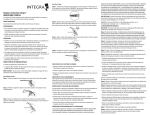
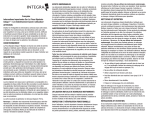
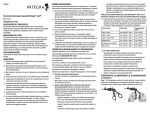
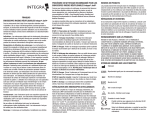
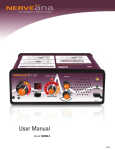
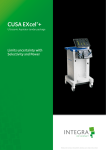
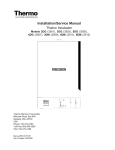
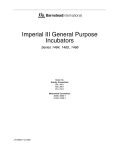
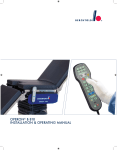

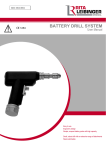

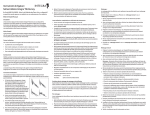
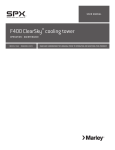

![RS419 Ring Scanner Quick Reference Guide [English] (P/N 72](http://vs1.manualzilla.com/store/data/005644067_1-e86e54c89d72fd57c6e04e83bb39ce34-150x150.png)
